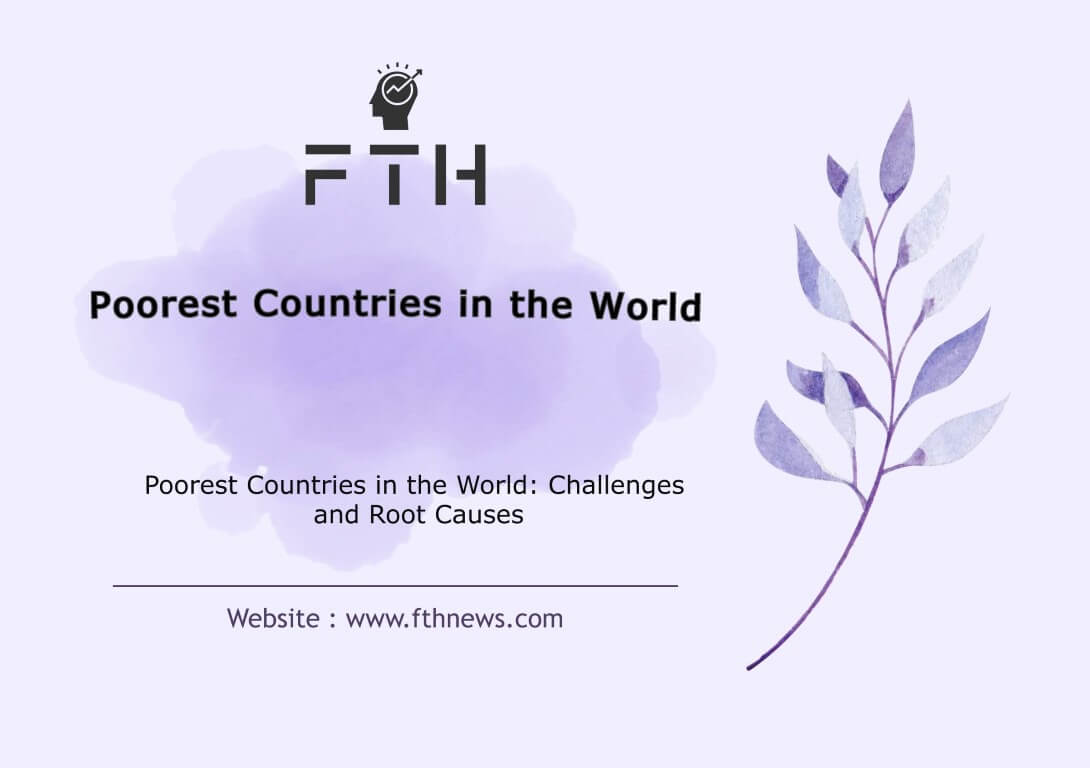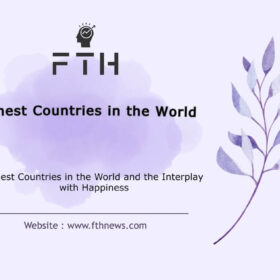
Poorest Countries in the World: Challenges and Root Causes
Embarking on a profound exploration of global economic disparities, we delve into the very heart of the matter – the Poorest Countries in the World. Despite the vast expanse of global wealth, numerous nations continue to grapple with the harsh realities of extreme poverty. In this comprehensive article, our focus sharpens on the concept of GDP per capita, guiding us through the intricate landscape of financial inequalities. Together, we’ll navigate the 10 Poorest Countries in the World , meticulously identified by the International Monetary Fund (IMF).
The Poorest Countries in the World :
South Sudan:
- Challenges: Economic struggles fueled by political instability and dependence on traditional agriculture.
- Backdrop: The world’s youngest country, South Sudan gained independence in 2011 but faces significant obstacles. Political instability, ongoing conflicts, and limited infrastructure hinder progress. The majority relying on traditional agriculture faces disruptions due to violence and extreme climate events.
Burundi:
- Challenges: Confronting socio-economic issues, including political instability and food insecurity.
- Backdrop: A small landlocked country in East Africa, Burundi grapples with significant challenges. Political instability, conflicts, and inadequate infrastructure contribute to economic struggles. Rapid population growth intensifies hardships, with 80 percent reliant on subsistence agriculture.
Central African Republic (CAR):
- Challenges: Struggling with political instability, armed conflicts, and economic challenges despite rich natural resources.
- Backdrop: Despite abundant resources in gold, oil, uranium, and diamonds, CAR faces stark poverty. The aftermath of war in Ukraine, severe flooding, and drought cycles exacerbate economic struggles, despite the nation’s wealth.
Somalia:
- Challenges: Plagued by political instability, armed conflicts, and a lack of infrastructure.
- Backdrop: Situated in the Horn of Africa, Somalia grapples with years of political instability, conflicts, and humanitarian crises. Absence of a functioning central government, limited infrastructure, and widespread poverty hinder progress.
Democratic Republic of the Congo (DRC):
- Challenges: Despite natural resource wealth, facing poverty due to internal conflicts and inadequate infrastructure.
- Backdrop: The DRC, Sub-Saharan Africa’s largest country, faces economic challenges. Most live in poverty, with limited access to education and healthcare. Internal conflicts, political instability, and inadequate infrastructure hamper economic progress.
Mozambique:
- Challenges: Resource-rich but grappling with poverty due to natural disasters, disease, and attacks from insurgent groups.
- Backdrop: Despite resource richness and strong GDP growth, Mozambique remains among the world’s poorest. Challenges include natural disasters, disease, rapid population growth, low agricultural productivity, and attacks from insurgent groups in the gas-rich north.
Niger:
- Challenges: High poverty rates due to limited natural resources, frequent droughts, and reliance on small-scale agriculture.
- Backdrop: A landlocked West African country, Niger faces economic challenges and high poverty rates. Limited natural resources, frequent droughts, and reliance on small-scale agriculture contribute to its economic struggles.
Malawi:
- Challenges: Vulnerable to climate change and fluctuating commodity prices, relying heavily on rain-fed agriculture.
- Backdrop: Despite beautiful landscapes, Malawi grapples with significant economic challenges. Heavy reliance on rain-fed agriculture makes it vulnerable to climate change and fluctuating commodity prices.
Chad:
- Challenges: Despite oil reserves, facing economic challenges and high poverty rates, vulnerable to weather-related shocks.
- Backdrop: Located in Africa, Chad faces significant economic challenges despite substantial oil reserves. Heavy reliance on rain-fed agriculture leaves it vulnerable to weather-related shocks and widespread food insecurity.
Liberia:
- Challenges: Enduring poverty due to violent conflicts, outbreaks, and unstable infrastructure.
- Backdrop: Liberia’s persistent poverty stems from violent conflicts, including civil wars and outbreaks like Ebola. Forced migration disrupts agriculture, contributing to food insecurity. International organizations strive to alleviate poverty through sustainable development efforts and investment in education and healthcare.
Poorest Countries in Each Continent:
Exploring the economic landscape of each continent unveils disparities and unique challenges. Here, we identify the poorest country in each continent, shedding light on the diverse factors influencing their economic standings.
Poorest Country in Africa:
South Sudan: Situated in the heart of Africa, South Sudan grapples with economic challenges fueled by political instability and reliance on traditional agriculture. As the youngest country globally, gaining independence in 2011, it faces obstacles such as ongoing conflicts, limited infrastructure, and disruptions to traditional agriculture due to violence and extreme climate events.
Poorest Country in Asia:
Nepal: Nestled in the Himalayas, Nepal confronts economic struggles as the poorest country in Asia. Despite its breathtaking landscapes, factors such as political instability and limited access to resources contribute to its economic challenges. Efforts towards sustainable development are crucial to uplift Nepal from its current economic hardships.
Poorest Country in Australia:
Papua New Guinea: While Australia itself is a developed nation, the continent of Australia includes regions facing economic challenges. Papua New Guinea, with its rich cultural diversity, stands as the poorest country in this continent. Economic struggles persist due to issues like political instability, limited infrastructure, and economic dependency on agriculture.
Poorest Country in Europe:
Ukraine: In Eastern Europe, Ukraine grapples with economic challenges, earning the distinction of being the poorest country in the continent. Despite its vast agricultural potential, issues such as political turmoil, conflicts, and economic instability contribute to Ukraine’s current economic struggles.
Poorest Country in North America:
Haiti: In the Caribbean region of North America, Haiti faces economic hardships, earning the title of the poorest country in this continent. Challenges include political instability, natural disasters, and limited access to resources. International support and sustainable development initiatives are crucial for Haiti’s economic progress.
Poorest Country in South America:
Venezuela: South America’s economic landscape is diverse, and Venezuela stands out as the continent’s poorest country. Despite its oil wealth, economic mismanagement, political instability, and international sanctions contribute to Venezuela’s current economic challenges.
Understanding the economic struggles of these countries requires a nuanced perspective, considering historical, political, and social factors. Addressing the root causes is vital for fostering sustainable development and uplifting these nations from the cycle of poverty.
Understanding GDP per Capita:
Gross Domestic Product (GDP), the barometer of a nation’s economic activity, quantifies the total value of goods and services produced annually.
To delve deeper into a country’s economic health, this figure is divided by its population, yielding GDP per capita. However, this straightforward calculation faces challenges when confronted with nuances in the cost of living and inflation rates. Recognizing these limitations, Purchasing Power Parity (PPP) emerges as a crucial factor in our analysis. By factoring in local costs and inflation rates, PPP facilitates a more nuanced and equitable comparison of a country’s standard of living, offering a comprehensive perspective on its economic landscape.
Understanding the Causes of Poorest Countries in the World:
Peering into the complex tapestry that defines the economic struggles of the Poorest Countries in the World, we unravel a web of interconnected challenges. Each country faces a unique set of circumstances that contribute to its precarious position on the global economic stage. Let’s delve into the root causes that underpin the struggles of these nations:
Political Instability:
- Impact: Political turmoil disrupts governance and economic stability.
- Example: South Sudan, the world’s youngest country, grapples with political instability, hindering progress and fostering economic challenges.
Armed Conflicts:
- Impact: Ongoing conflicts perpetuate violence, displacement, and hinder economic growth.
- Example: Somalia faces prolonged armed conflicts, contributing to a lack of infrastructure and impeding economic development.
Limited Infrastructure:
- Impact: Insufficient infrastructure constrains economic development and hampers access to essential services.
- Example: Central African Republic, rich in resources, struggles with inadequate infrastructure, hindering the utilization of its natural wealth.
Reliance on Traditional Agriculture:
- Impact: Dependence on subsistence farming exposes economies to vulnerabilities.
- Example: Burundi’s reliance on subsistence agriculture contributes to food insecurity, exacerbating its socio-economic challenges.
Natural Disasters:
- Impact: Countries face economic setbacks due to the destructive force of natural disasters.
- Example: Mozambique, despite resource richness, grapples with poverty exacerbated by natural disasters and attacks from insurgent groups.
Disease and Health Crises:
- Impact: Health crises disrupt societies, strain healthcare systems, and hinder economic progress.
- Example: Liberia’s history of outbreaks, including Ebola, disrupts agriculture and contributes to food insecurity.
Climate Change Vulnerability:
- Impact: Vulnerability to climate change poses threats to agriculture and livelihoods.
- Example: Malawi’s heavy reliance on rain-fed agriculture makes it susceptible to climate change and fluctuating commodity prices.
Resource Mismanagement:
- Impact: Despite natural resource wealth, mismanagement can lead to economic stagnation.
- Example: The Democratic Republic of the Congo faces internal conflicts and inadequate infrastructure, impacting the utilization of its rich natural resources.
By scrutinizing these underlying factors, we gain a nuanced understanding of the multifaceted nature of poverty in these nations. Addressing these root causes is pivotal for fostering sustainable development and uplifting the economies of the world’s most vulnerable countries.
The Complexity of Poverty:
As we navigate through the GDP per capita ranking of the world’s poorest countries, it becomes imperative to recognize the intricate and multi-dimensional nature of poverty. Beyond the numerical metrics, poverty is a complex and nuanced concept influenced by a myriad of factors that extend far beyond mere economic measurements. Delving deeper into this complexity unveils a broader perspective, where the challenges faced by these nations transcend traditional financial indicators.
Healthcare Inequities:
- Impact: Limited access to healthcare services exacerbates health disparities and contributes to the cycle of poverty.
- Example: Nations grappling with high poverty rates often face challenges in providing adequate healthcare, impacting the overall well-being of their populations.
Educational Barriers:
- Impact: Insufficient access to quality education perpetuates a lack of skills and limits opportunities for economic advancement.
- Example: The correlation between poverty and limited educational resources underscores the need for comprehensive strategies to break the cycle of poverty through improved education.
Quality of Life Considerations:
- Impact: Poverty extends beyond monetary constraints, affecting the overall quality of life, including living conditions, access to clean water, and sanitation.
- Example: The absence of basic amenities in impoverished regions underscores the broader challenges that communities face, impacting their daily lives.
Social and Political Stability:
- Impact: Unstable political environments contribute to economic uncertainties and hinder long-term development.
- Example: Nations struggling with political instability find it challenging to attract investments and implement sustainable economic policies, perpetuating the cycle of poverty.
Environmental Sustainability:
- Impact: Vulnerability to environmental changes further compounds the challenges faced by impoverished nations.
- Example: Climate change disproportionately affects economically disadvantaged regions, leading to increased food insecurity and economic instability.
Access to Technology and Information:
- Impact: Limited technological resources impede access to information and global opportunities.
- Example: The digital divide widens the gap between prosperous and impoverished nations, hindering the latter’s ability to participate fully in the global economy.
Social Inequality and Discrimination:
- Impact: Persistent social inequalities and discrimination hinder inclusive economic growth.
- Example: Societal disparities based on gender, ethnicity, or other factors contribute to economic exclusion, perpetuating poverty.
Community Empowerment and Resilience:
- Impact: Empowered and resilient communities are better equipped to break free from the cycle of poverty.
- Example: Initiatives fostering community empowerment and resilience play a vital role in sustainable development and poverty alleviation.
Recognizing the complexity of poverty goes beyond the confines of economic statistics, urging us to adopt a holistic approach that addresses the multifaceted challenges faced by the world’s most vulnerable populations. By acknowledging and understanding these broader dimensions, we can pave the way for comprehensive strategies that encompass social, economic, and human development.
Evaluation Criteria for the Poorest Countries in the World:
In our quest to unravel the complexities of poverty, we turn to the United Nations Human Development Report (UN HDR) for a nuanced evaluation that extends beyond traditional economic metrics. This holistic approach incorporates a spectrum of indicators, offering a comprehensive view of a nation’s well-being and its challenges. Let’s dissect the key evaluation criteria employed to discern the plight of the Poorest Countries in the World
Gross National Income (GNI):
- Significance: GNI measures a country’s total income, including earnings from abroad. It serves as a vital economic indicator.
- Insight: The GNI sheds light on a nation’s overall economic health and its ability to generate income, providing insights into its economic development and potential for poverty alleviation.
Life Expectancy:
- Significance: Life expectancy at birth reflects the average number of years a newborn is expected to live, showcasing the overall health and healthcare access within a nation.
- Insight: Countries with higher life expectancies often exhibit better healthcare systems and improved living conditions, contributing to a more robust human development profile.
Schooling Indicators:
- Significance: Educational attainment is a crucial aspect of human development. Expected and mean years of schooling provide insights into a country’s commitment to education.
- Insight: Nations prioritizing education demonstrate a long-term investment in their human capital, fostering the development of skilled individuals capable of contributing to economic growth and innovation.
Human Development Index (HDI) Value:
- Significance: HDI is a composite index that combines GNI per capita, life expectancy, and education indicators. It offers a holistic measure of human development.
- Insight: HDI provides a comprehensive snapshot of a country’s overall well-being, taking into account both economic and social dimensions. A low HDI value indicates challenges in multiple aspects of human development.
Quality of Life Index:
- Significance: Assessing factors such as living conditions, access to basic amenities, and overall satisfaction contributes to a more holistic understanding of a nation’s quality of life.
- Insight: Beyond economic measures, the quality of life index considers the broader aspects of well-being, offering a more inclusive evaluation that accounts for the daily experiences of the population.
Economic Vulnerability Index:
- Significance: This index gauges a country’s susceptibility to external economic shocks and vulnerabilities, providing insights into its resilience.
- Insight: Understanding economic vulnerability is crucial for devising strategies to mitigate the impact of external factors on a nation’s economy, especially for those already grappling with poverty.
Extended Real Quality of Life Index:
- Significance: A comprehensive assessment that considers environmental, health, educational, and socio-economic factors to gauge the overall quality of life.
- Insight: By incorporating a broad range of factors, this index offers a more nuanced understanding of the challenges and opportunities within a nation, guiding interventions for sustainable development.
By weaving together these diverse evaluation criteria, we aim to transcend the limitations of purely economic assessments and provide a holistic portrayal of the challenges faced by the world’s poorest countries. This multidimensional approach empowers us to craft targeted solutions that address the intricacies of poverty in its various forms.
Global Poverty Landscape:
The global landscape of poverty paints a stark reality, with an estimated 676 million people projected to be living in extreme poverty by the close of 2022. This sobering statistic underscores the pervasive nature of poverty, with a substantial portion of those affected residing in African nations. To comprehend the extent of this challenge, we turn to the World Bank’s internationally recognized poverty line, a crucial standard for gauging and addressing poverty.
Magnitude of Extreme Poverty:
- Projection: As we approach the end of 2022, the global count of individuals in extreme poverty is staggering, reaching approximately 676 million.
- Regional Disparities: The impact of extreme poverty is disproportionately felt, with a significant concentration in African nations, highlighting the urgent need for targeted interventions in this region.
World Bank’s Poverty Line:
- Benchmark for Measurement: The World Bank’s poverty line, established at $2.15 per person per day at purchasing power parity, serves as a vital benchmark for poverty measurement globally.
- Purchasing Power Parity: Recognizing the varying purchasing power across nations, this standard enables a more equitable comparison of poverty levels, accounting for local economic conditions.
Challenges and Implications:
- Beyond Monetary Constraints: Poverty, as measured by the World Bank, extends beyond a mere lack of financial resources. It encompasses a broader spectrum of challenges, including limited access to education, healthcare, and basic necessities.
- Impact on African Nations: The concentration of extreme poverty in African nations highlights the complex socio-economic challenges faced by the continent, demanding comprehensive strategies to address the root causes.
Sustainable Development Goals (SDGs):
- Alignment with SDG 1: The efforts to alleviate extreme poverty align with the first of the United Nations’ Sustainable Development Goals (SDGs), emphasizing the importance of eradicating poverty in all its forms.
- Global Collaboration: The scale of the poverty challenge necessitates collaborative efforts on a global scale, with nations and organizations working together to achieve tangible progress.
Inclusive Poverty Measurement:
- Multidimensional Approach: Recognizing that poverty is a multi-dimensional concept, the World Bank’s poverty line takes into account not only income levels but also factors such as access to education, healthcare, and overall well-being.
- Holistic Solutions: By adopting a more inclusive measurement approach, interventions can be tailored to address the diverse facets of poverty, ensuring a comprehensive and sustainable impact.
Understanding the global poverty landscape requires a nuanced perspective that goes beyond numerical counts. It calls for a commitment to addressing the multifaceted challenges faced by individuals and communities worldwide. As we strive to meet the objectives set forth by the Sustainable Development Goals, the World Bank’s poverty line serves as a critical tool for assessing progress and guiding initiatives aimed at eradicating poverty on a global scale.
Conclusion: Poorest Countries in the World
As we explore the economic challenges faced by the world’s poorest countries, it’s essential to recognize the multi-faceted nature of poverty. By understanding the root causes and evaluating various criteria, we can work towards addressing the complex issues that contribute to global poverty.
FAQ
What is the 10 poorest country in the world?














